The effects of acceleration and gravity aren't exactly the same of course, but we can generate 'artificial gravity' by spinning things round, like swinging a bucket of water in a horizontal plane - the water stays in, the same as it would if you just put the bucket down. As a reality check, I put some marbles in the center of a smooth, flat plate on a record player turntable. When I lifted the needle to get it turning, all the marbles hit the edge of the plate within a second or so.
For all the 'Physics Deniers' out there, let's work out what would happen if you had a large, well-insulated tube of air (the larger and longer the better) being spun around an axis at one end (the faster the better).
1. While standing still, the density, pressure and temperature are constant along the whole length (I haven't bothered with units or numbers on the axes, this is about basic principles):
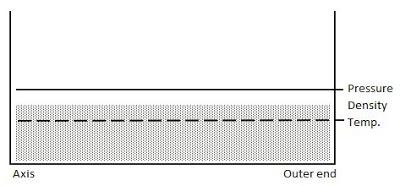 2. When it is spinning around the axis, the gas will be pushed towards the outer end (the same as the marbles on a plate). So density goes up at the outer end and down at the axis end. I've assumed that the increase is linear (which turns out to be a realistic assumption):
2. When it is spinning around the axis, the gas will be pushed towards the outer end (the same as the marbles on a plate). So density goes up at the outer end and down at the axis end. I've assumed that the increase is linear (which turns out to be a realistic assumption):
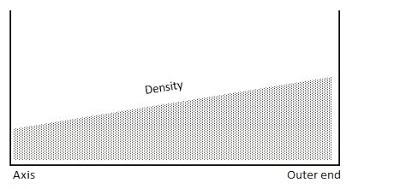 3. The pressure at any point along the tube is the mass of all the gas to the left of it pressing 'down' on it, which is the area of the 'density' shape to the left of that point. Pressure increases geometrically from left to right (the length and height of the upper triangle increase by the same fraction with each step to the right, so the area increases by that fraction to the power of 2):
3. The pressure at any point along the tube is the mass of all the gas to the left of it pressing 'down' on it, which is the area of the 'density' shape to the left of that point. Pressure increases geometrically from left to right (the length and height of the upper triangle increase by the same fraction with each step to the right, so the area increases by that fraction to the power of 2):
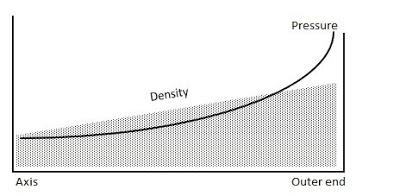 4. Temperature is proportional to pressure divided by density. There are no physical barriers along the tube, so the ratio P/D stays constant along the whole length. So temperature goes up from left to right. This is the bit the Physics Deniers can't understand and don't accept. The gas can't become isothermal again, because the density and pressure are dictated by the amount of gas, the length of the tube, how fast it is spinning etc, and temperature is a function of those two inputs. So the inner surface at the outer end ends up warmer than when it was standing still, and the axis end ends up cooler. No thermal energy has been added to the gas - it is just distributed differently.
4. Temperature is proportional to pressure divided by density. There are no physical barriers along the tube, so the ratio P/D stays constant along the whole length. So temperature goes up from left to right. This is the bit the Physics Deniers can't understand and don't accept. The gas can't become isothermal again, because the density and pressure are dictated by the amount of gas, the length of the tube, how fast it is spinning etc, and temperature is a function of those two inputs. So the inner surface at the outer end ends up warmer than when it was standing still, and the axis end ends up cooler. No thermal energy has been added to the gas - it is just distributed differently.
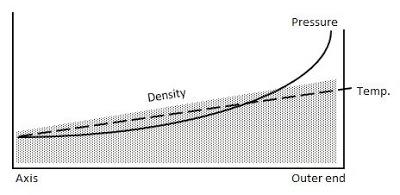 5. What relevance does this have to the gravito-thermal effect? Simple, you just rotate Diagram 4 clockwise by 90 degrees and relabel the axes. This now matches the measured profile of the troposphere - density and temperature go down in a fairly linear fashion and pressure goes down geometrically.
5. What relevance does this have to the gravito-thermal effect? Simple, you just rotate Diagram 4 clockwise by 90 degrees and relabel the axes. This now matches the measured profile of the troposphere - density and temperature go down in a fairly linear fashion and pressure goes down geometrically.
The explanation for the temperature profile is slightly different to the spinning tube - when air rises, it converts thermal energy to potential energy; when air falls (or presses down on air beneath it), it converts potential energy to thermal energy. The first approximation for the lapse rate is simply acceleration due to gravity ÷ specific heat capacity of air; which is then modified by the opposite effect of the latent heat of evaporation/condensation, which cools the surface and manifests itself as thermal energy higher up.
But whatever the explanation, it reminds us that the effects of gravity and artificial gravity/acceleration are very similar; and acceleration due to gravity is a lot, it is slightly more than the forward acceleration of a supercar that can hit 60 mph in three seconds*. The laws of physics that apply to a bucket of water also apply to the troposphere:
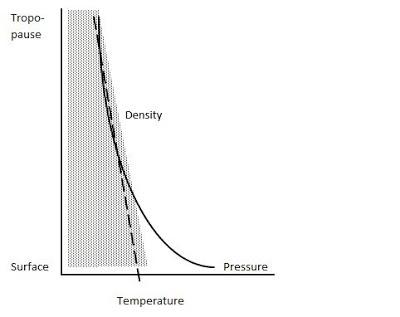 6. "But what about radiation and greenhouse gases?" shout the Physics Deniers. Well, what about them? You can explain what happens in the spinning tube without mentioning them and they are irrelevant when you rotate the diagram and have real gravity instead of artificial gravity. In the spinning tube, there was a fixed amount of thermal energy to start off with, which was recycled towards the outer end. Earth gets enough sunshine to keep the whole system at a steady average ~255K (fixed) and the laws of physics ensure that the thermal energy is recycled downwards to cool the air at higher altitudes to ~220K and warm the surface to ~288K.
6. "But what about radiation and greenhouse gases?" shout the Physics Deniers. Well, what about them? You can explain what happens in the spinning tube without mentioning them and they are irrelevant when you rotate the diagram and have real gravity instead of artificial gravity. In the spinning tube, there was a fixed amount of thermal energy to start off with, which was recycled towards the outer end. Earth gets enough sunshine to keep the whole system at a steady average ~255K (fixed) and the laws of physics ensure that the thermal energy is recycled downwards to cool the air at higher altitudes to ~220K and warm the surface to ~288K.
---------------------------------------
7. For sure, the surface is emitting more radiation than actually gets to space (which must be approx. equal to the amount received from the Sun each day) but there's no point subtracting one from the other, it's not comparing like with like.
The surface is as warm as it is, and emits the corresponding amount of radiation, it simply doesn't care what happens higher up. Somehow or other, the whole system will ensure that incoming and outgoing radiation balance somehow, whether we point the finger at greenhouse gases trapping radiation or the low emissivity of clouds. If there were no 'greenhouse gases' or clouds, maybe the 'emissivity' of the surface would fall by 40%? It would transfer more energy to the air by conduction and convection, leaving less to be lost as radiation**, so it no longer acts like a black body?
* People picture the atmosphere (or anything else) resting on the Earth's surface as a static situation. In some ways, you can imagine the surface accelerating upwards at 9.8 m/s - as fast as the fastest supercar doing 0 to 60 mph - and pushing everything up accordingly. Imagine a ship moored in a river flowing at 10 knots, there's a bow wave in front of it. Or the same ship traveling up a canal at 10 knots, there's the same bow wave. If you lean over the bow and look straight down, you can't tell whether the ship is moored or moving. So it's like the Earth's surface is a giant piston pushing and compressing (hence warming) a ten-ton 'bow wave' of air in front of it.
** The top 1m of the ocean surface only radiates away about 1.4% of its total (thermal) energy overnight, sufficient to cool it by ~4K, which matches up with the typical diurnal temperature range for the surface of a fairly still ocean and the air immediately above it. Losing energy by radiation is a slow and inefficient process - blacksmiths quench red hot steel by plunging it into water; how much longer would it take if they held the red hot steel just above the surface of the cold water and allowed radiation to do its thing?
Here endeth today's lesson. I'd rather be a Climate Denier than a Physics Denier.
